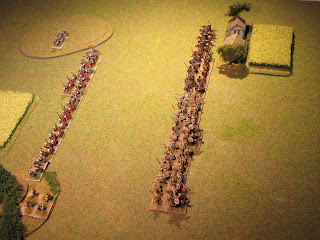I have continued the experiments, playing DBA with
uneven odds, and used the Polybian Roman against the Gallic army. The Gallic
horde consists of three sub-tribes and one of these have their number increased
by two extra elements.
For the new reader I would like to preface this by
stating these experiments are meant to help build historical scenarios where
the antagonists are fighting one another with an uneven number of troops. A number of examples
come to mind but high on my list are the Maccabean battles against the Seleucid
armies. My preference is to find a way
within the rule system that can best duplicate the conditions set historically rather than tinker with the combat abilities of the troop types.
Test one
All tests were fought over 'arable' terrain which meant
the presence of fields, a wood and a gentle hill. Both sides deployed on an identical frontage with the barbarians making use of deeper formations.
The Romans withdrew their left wing to establish a new
defensive line resting on the hill. This forced the Gauls to move forward using a series of wheels which took up needed time.
As expected with the changes in direction and
realignment of formations not all the groups could do so on the same bound; the situation developed into piecemeal assaults. Rome managed to beat back the central tribe but
the eventual assault by both Gallic wings was enough to send the Romans off the field. Score
3 – 4 for Gaul.
Test two
Both battle-lines remained unchanged in their deployment, but the Gallic
warlord’s group formed up on the right so as to take make better use of his advantage of cavalry.
This battle lacked the finesse of the first one but
was no less exciting. Rome did break the two groups of the left wing and
centre. The Gallic warlord could not hold the rout that followed as all his
energy (pip score) was focused on breaking the Roman left flank and perhaps
killing the Roman general.
This was a closely fought battle with both sides one
element short of breaking. Unfortunately Fortuna departed confident of a Roman
victory and in stepped the Muses. Score
6 – 4 for Gaul.
Test three
Rome, as defender in all three games, deployed first
and kept its standard formation. At the opposite end of the field, Gaul
deployed in a far deeper formation than before.
Rome took the offensive and would take advantage of their deeper
formation to attack their exposed left flank. The Gauls responded
by holding their left back while the centre and right wing rushed forward to
strike the Roman wall.
Rome did not relinquish the initiative and continued the attack first driving into the Gallic centre and left wing.
Roman overconfidence was quickly dissipated as Gallic
ferocity succeeded in destroying the triarii and hastati in short order. Score 3 – 4 for Gaul.
Some
observations
Despite the barbarians having to move by tribal groups
they did manage to overpower Roman resistance in all three tests. It is
possible that odds of 5:3 are a threshold for the Polybian, but their main
weakness is a shortage of mounted troops which are useful when fighting warband.
On a historical note, when fighting the Galatians of the east, Rome could make use
of the Pergamene as allies with their knights-class cavalry.
Further on a tactical note, interspersing the Gallic cavalry among the
warband worked well as the triarii could not benefit from side support against
mounted. There were plans to group all the cavalry together, but this was
discarded as it would require too many pips to be of any use.
Next tests will bring two cavalry armies to the game
table.
Cheers,











Another way to reduce command control of large forces is to have all PIPs assigned by the CinC, but with a turn or two of delay before the PIP "arrives" at the sub-command.
ReplyDeleteThe CinC must consider "sending" a PIP which might not be needed after all.